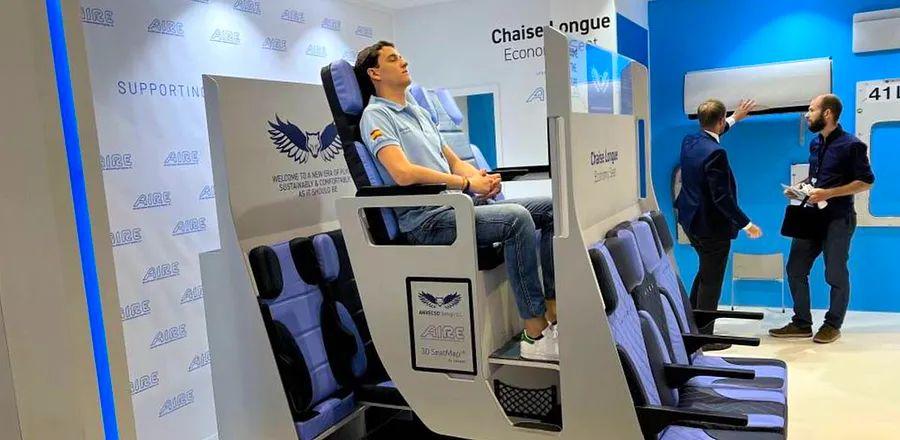Could Double-Decker Airline Seats Become a Reality?

One part of air travel that has seen little improvement over the years is the basic coach-class airline seat.
Every few years, an ambitious concept for 'reinventing' these seats emerges, only to be quickly labeled as impractical or unsafe. Remember the notorious ‘standing seat’ proposal, which would have crammed budget passengers into nearly upright rows? A prototype introduced a while back was likened to a medieval torture device, and the negative publicity likely deterred airlines from pursuing it further.
There are significant challenges to getting such radical changes approved by government regulators, especially since airlines must demonstrate the ability to evacuate a full aircraft in 90 seconds during emergencies. A stark reminder of the critical nature of safe evacuations occurred on June 21 in Miami when a Red Air jet, a Dominican airline, slid off the runway due to landing gear failure; at least four of the 140 passengers on board sustained injuries while escaping the damaged aircraft.
I experienced a double-decker airplane seat | CNN Travel https://t.co/IRT4kXMMCJ — Victor Asal (@Victor_Asal) June 15, 2022
The quest to accommodate more passengers on flights remains enticing for airlines as air travel demand surges. Enter the 'double-decker' cabin design, which gained attention last month at the Aircraft Interiors Expo (AIX) in Hamburg, Germany. This design concept, known as the Chaise Longue Economy Seat, proposes seating coach-class passengers across two levels, connected by ladder-like steps, with the upper level utilizing space freed by removing overhead bins (carry-on luggage would be stored in a bin beneath the higher seats).
What’s even more surprising is that this innovative concept didn’t originate from a seasoned seat designer but from a 22-year-old entrepreneur, Alejandro Nuñez Vicente, who conceived it while studying engineering at TU Delft University in the Netherlands. Inspired by his struggles to fit his six-foot frame into cramped economy seats on his flights to Madrid, Nuñez Vicente asserts that his design would enhance comfort by providing more legroom—up to 32 inches of seat pitch, compared to the typical 28 to 30 inches in standard coach configurations. To attract airline decision-makers, he also noted that this setup could boost seating capacity by 5 to 10 percent. He believes it could be implemented in wide-body jets like the Airbus A330 or Boeing 787.
The seat has received mixed feedback from industry experts thus far. “The design is certainly unconventional,” notes Henry Harteveldt, cofounder and travel analyst at Atmosphere Research. On the plus side, he highlights that it could enable airlines to increase passenger density without sacrificing legroom. However, he also points out that “we’ve never had two levels of seats in a cabin, primarily due to aviation safety concerns.”
Travel expert Gary Leff, founder of the View From the Wing blog, remains doubtful. He states, “Any nonstandard seat design will face significant challenges in gaining regulatory approval.”
Nuñez Vicente’s idea isn’t the first to propose double-decker coach-class seating. A few years back, a group of designers patented an economy-class layout called the “Zephyr,” featuring bunk-bed style compartments with lie-flat seats (distinct from the recently revealed Skynest napping pods that Air New Zealand will incorporate into economy). While this concept would likely appeal to weary coach travelers, especially on long-haul flights, it is still in its initial development phases.

Courtesy of Crystal Cabin Award
Egress and evacuation testing is just one aspect of the approval process for new cabin designs; similar to automobile seats, airline seats must pass extensive crash tests before receiving certification. The latest regulations for crash resistance mandate that all seats on aircraft manufactured after 2009 endure impacts of up to 16 Gs—nearly double the former requirement of 9 Gs. Sample seats are equipped with test dummies and subjected to simulated crash scenarios, much like how airbags are tested in cars. The entire journey from design conception to certification can span five years or more.
Any unconventional design will attract increased scrutiny. When Air New Zealand sought approval for its innovative Skycouch—a row of economy seats that can transform into a bed for two—it faced prolonged review from the U.S. Federal Aviation Administration, which required approval for flights to and from the U.S. This delay stemmed from concerns regarding the sufficiency of seat belts in this unusual configuration, though the seating was ultimately approved.
Not all cabin innovations focus on maximizing passenger capacity. At the recent AIX show, organizers presented the Crystal Cabin Awards for inventive designs prioritizing health, safety, and adaptable configurations. These ranged from an ‘airshield’ designed to reduce germ transmission to a ‘shift cabin interior’ that allows seating arrangements to be modified for work or relaxation. This year, Ken Kirtland from the Georgia Institute of Technology earned the award in the University category for his forward-thinking regional airline concept featuring zero-emission electric aircraft with ‘Portal’ cabins offering panoramic views.

Courtesy of Crystal Cabin Awards
William McGee, senior fellow for aviation and travel at the American Economic Liberties Project and author of Attention All Passengers, suggests that in light of current air travel conditions, the FAA may need to monitor airplane seat safety and layouts more closely. He notes, “Planes are packed tighter, and travelers are bringing more bags onboard due to checked baggage fees.”
With all the challenges involved, it's no surprise that economy seats have remained relatively unchanged over the years. But hey, flying in cattle class builds character, right? And one can always dream of a future where air travel is safer, healthier, more comfortable, and more sustainable.
Evaluation :
5/5



